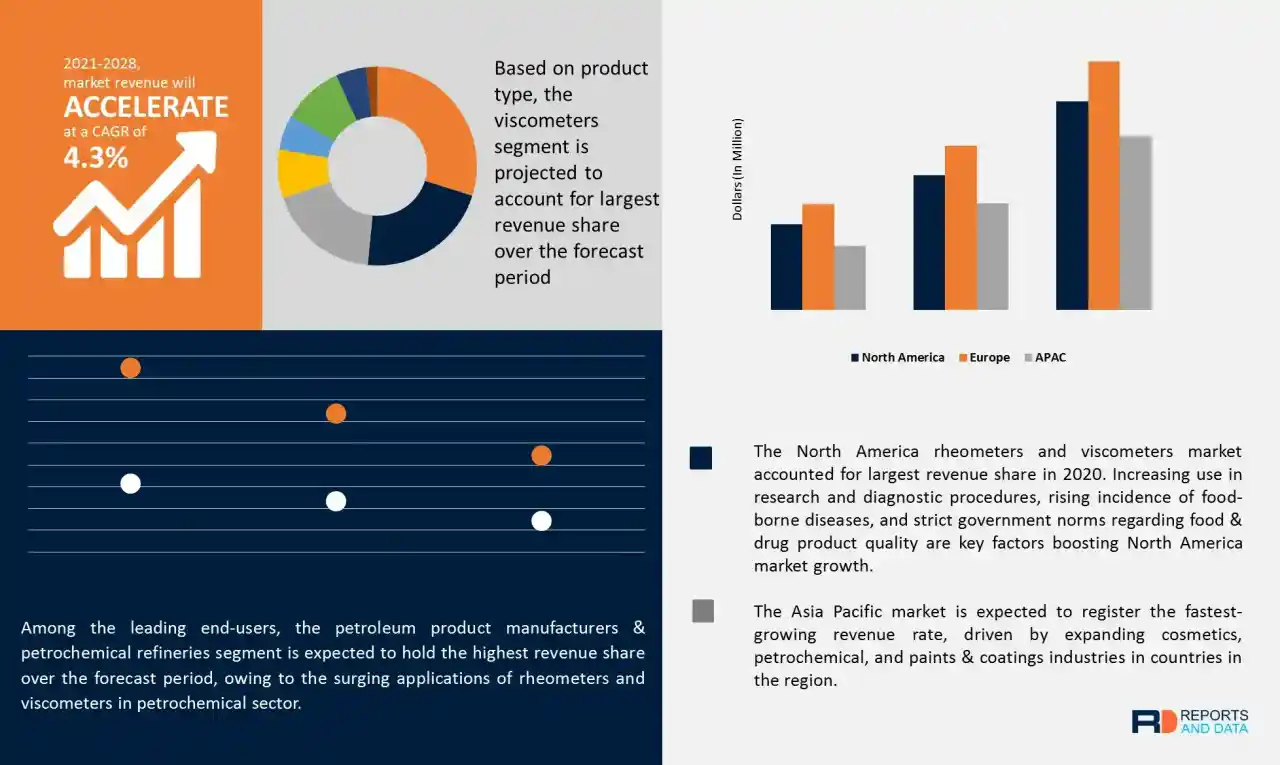Want to curate the report according to your business needs
Report Description + Table of Content + Company Profiles

Source: Reports and data
| Study Period | 2018-2028 |
| Base Year | 2019 |
| CAGR | 4.30 |


The global rheometers and viscometers market size was USD 791.62 million in 2020 and is expected to register a CAGR of 4.3% during the forecast period. Steady market revenue growth is driven by increasing demand for advanced rheometers and viscometers across a wide range end-use industries including biotechnology and pharmaceutical, Petrochemical refineries, Cosmetics and food & beverage industries, and from chemical and material manufacturers.

The extensive use of rheometers and viscometers in research and diagnostic laboratories, rising government investments in R&D activities in pharmaceutical, cosmetics, and food & beverage industries, and rising focus on laboratory automation are the other key factors propelling market revenue growth. Surging demand for premium-quality pharmaceuticals and cosmeceuticals, expanding chemical and petrochemical industries, and stringent government regulations for product quality and safety is expected to further bolster global rheometers and viscometers market growth going ahead.
Rheometers and viscometers are devices used to measure the viscosity of different fluid samples. A rheometer is a device that measures the rheological and flow properties of a material such as liquids, suspensions, polymers, or slurry flows, and the way these materials respond to an applied force. Rotational rheometers are most widely used rheometers that measure a fluid’s macro-rheological properties by applying a continuous shear motion to it and eliciting data about elasticity and structure of the specific material. These types of rheometers are predominantly used for complex microstructures, including sludge, mud, suspensions, glass formers such as silicates, bodily fluids such as blood, and various foods and additives. A viscometer is a device that measures a fluid’s viscosity and flow properties. However, a rheometer is considered superior to a viscometer in terms of performance and is used for fluids with viscosities varying in different flow conditions. The measurement range of a viscometer is about 0.1 to 103 s-1; whereas, that of a rheometer ranges from 10-6 to 105 s-1. Generally, the viscosity of a fluid needs to be high at lower shear rates so as to avoid slumping or sedimentation. Therefore, rheometers are considered more appropriate for viscosity testing, product development process, and quality control due to their relatively higher performance, low torque capabilities, better speed control, and increased versatility.
Rheometers and viscometers play a vital role in pharmaceutical research and manufacturing and facilitate product quality control. These devices determine the flow and behavior various materials, such as evaporation fluids, gels, pills, and catheter polymers. In the cosmetics and personal care industry, viscosity testing is important for quality control and processability of the product during manufacture. Moreover, rheometers and viscometers are extensively used by food & beverage manufacturers to monitor the batch quality and consistency of various food and beverage products such as milk and Honey. Hence, such factors are predicted to stimulate global market growth going ahead.
Several mechanical parts of rotational rheometers are exposed to air, which could potentially contaminate or damage these parts over a certain period of time. These devices require higher sample volumes as compared to those required for other types of rheometers, making the process quite expensive. Moreover, in rotational rheometers, specific materials are prone to intrinsic storage deformation, which eventually impacts measurement results. Such disadvantages associated with rotational rheometers are expected to hamper market growth to some extent going ahead.
Based on product type, the global rheometers and viscometers market is segmented into rheometers (dynamic rotational rheometers, torque rotational rheometers, oscillatory rheometers, capillary rheometers, high-throughput rheometers, and others) and viscometers (capillary viscometers, rotational viscometers, process viscometers, and others). The viscometers segment is expected to account for significantly larger revenue share that the viscometers segment over the forecast period due a variety of factors. Viscometers are widely used in research and diagnostic laboratories, pharmaceutical industry, and petrochemical refineries, owing to higher accuracy, capability of analyzing different samples under varied temperatures, faster processing time, and ease of handling. Moreover, the efficiency of blood viscometers in cardiovascular disease treatment is another factor driving increasing preference, which is expected to continue to support revenue growth of this segment.
The global rheometers and viscometers market is segmented on the basis of end-use into pharmaceutical, biotechnology, and cosmeceutical companies, research laboratories and academic institutions, food & beverage manufacturers, chemical and material manufacturers, paints & coatings manufacturers, petroleum product manufacturers and petrochemical refineries, and others. The petroleum product manufacturers & petrochemical refineries segment is projected to lead in the global market in terms of revenue over the forecast period. The expanding petrochemical sector and growing use of rheometers and viscometers in petroleum production processes are primary factors driving revenue growth of this segment.
The global rheometers and viscometers market is geographically segmented into North America, Europe, Asia Pacific, Latin America, and Middle East & Africa. The North America rheometers and viscometers market accounted for highest revenue share in 2020. Increasing applications of rheology and viscosity analyses in the healthcare industry, increasing research and diagnostic procedures, growing incidence of food-borne illnesses, and improved regulations for food & drug quality checks are key factors fueling North America market revenue growth. The market in Asia Pacific is projected to register the fastest revenue growth rate than other regional markets over the forecast period, primarily due to booming cosmetics, petrochemical, and paints & coatings industries in countries in the region.
Key players include Anton Paar, Thermo Fisher Scientific, Brookfield Engineering Laboratories, Waters Corporation, Cannon Instrument Company, Bartec Group, Dynisco, Emerson, GBC Scientific Equipment Pty Ltd., Hydramotion, Lamy Rheology Instruments, Petroleum Analyzer Company LP (PAC LP), Goettfert, Shimadzu Corporation, and Spectris.
For the purpose of this report, the global rheometers and viscometers market has been segmented based on product type, sample type, end-use, and region:
| PARAMETERS | DETAILS |
| The market size value in 2020 | USD 791.62 Million |
| CAGR (2020 - 2028) | 4.3% |
| The Revenue forecast in 2028 |
USD 1,087.57 Million |
| Base year for estimation | 2019 |
| Historical data | 2017-2018 |
| Forecast period | 2020-2028 |
| Quantitative units |
|
| Report coverage | Revenue forecast, company ranking, competitive landscape, growth factors, and trends |
| Segments covered | By Product Type, Sample Type, End-user, Regional Outlook |
| By Product Type |
|
| By Sample Type |
|
| By End-user |
|
| Regional scope | North America; Europe; Asia Pacific; Latin America ; Middle East & Africa |
| Country scope | U.S.; Canada; U.K.; Germany; France; BENELUX; China; India; Japan; South Korea; Brazil; Saudi Arabia; UAE; Turkey |
| Key companies profiled | Anton Paar, Thermo Fisher Scientific, Brookfield Engineering Laboratories, Waters Corporation, Cannon Instrument Company, Bartec Group, Dynisco, Emerson, GBC Scientific Equipment Pty Ltd., Hydramotion, Lamy Rheology Instruments, Petroleum Analyzer Company LP (PAC LP), Goettfert, Shimadzu Corporation, and Spectris. |
| Customization scope | 10 hrs of free customization and expert consultation |
Facing issues finding the exact research to meet your business needs? Let us help you! One of our Research Executives will help you locate the research study that will answer your concerns. Speak to Analyst Request for Customization
Request a FREE Sample here to understand what more we have to offer over competition…
upto20% OFF
upto20% OFF
Want to curate the report according to your business needs
Report Description + Table of Content + Company Profiles
